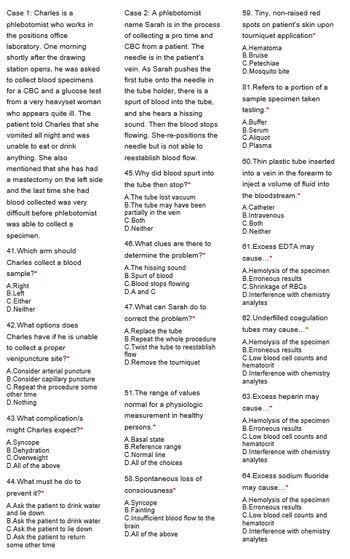Question
please answer all qauestion

Transcribed Image Text:Case 1: Charles is a
phlebotomist who works in
the positions office
laboratory. One morning
shortly after the drawing
station opens, he was asked
to collect blood specimens
for a CBC and a glucose test
from a very heavyset woman
who appears quite ill. The
patient told Charles that she
vomited all night and was
unable to eat or drink
anything. She also
mentioned that she has had
a mastectomy on the left side
and the last time she had
blood collected was very
difficult before phlebotomist
was able to collect a
specimen.
41. Which arm should
Charles collect a blood
sample?*
A.Right
B.Left
C.Either
D.Neither
42. What options does
Charles have if he is unable
to collect a proper
venipuncture site?"
A.Consider arterial puncture
B.Consider capillary puncture
C.Repeat the procedure some
other time
D.Nothing
43. What complication/s
might Charles expect?"
A.Syncope
B.Dehydration
C.Overweight
D.All of the above
44. What must he do to
prevent it?"
A.Ask the patient to drink water
and lie down
B.Ask the patient to drink water
C.Ask the patient to lie down
D.Ask the patient to return
some other time
Case 2: A phlebotomist
name Sarah is in the process
of collecting a pro time and
CBC from a patient. The
needle is in the patient's
vein. As Sarah pushes the
first tube onto the needle in
the tube holder, there is a
spurt of blood into the tube,
and she hears a hissing
sound. Then the blood stops
flowing. She-re-positions the
needle but is not able to
reestablish blood flow.
45. Why did blood spurt into
the tube then stop?*
A.The tube lost vacuum
B.The tube may have been
partially in the vein
C.Both
D.Neither
46. What clues are there to
determine the problem?"
A.The hissing sound
B.Spurt of blood
C.Blood stops flowing
D.A and C
47. What can Sarah do to
correct the problem?*
A.Replace the tube
B.Repeat the whole procedure
C.Twist the tube to reestablish
flow
D.Remove the tourniquet
51. The range of values
normal for a physiologic
measurement in healthy
persons.*
A.Basal state
B.Reference range
C.Normal line
D. All of the choices
58.Spontaneous loss of
consciousness*
A.Syncope
B.Fainting
C.Insufficient blood flow to the
brain
D.All of the above
59. Tiny, non-raised red
spots on patient's skin upon
tourniquet application*
A.Hematoma
B.Bruise
C.Petechiae
D.Mosquito bite
81. Refers to a portion of a
sample specimen taken
testing.*
A.Buffer
B.Serum
C.Aliquot
D.Plasma
60. Thin plastic tube inserted
into a vein in the forearm to
inject a volume of fluid into
the bloodstream.*
A.Catheter
B.Intravenous
C.Both
D.Neither
61.Excess EDTA may
cause...*
A.Hemolysis of the specimen
B.Erroneous results
C.Shrinkage of RBCs
D.Interference with chemistry
analytes
62. Underfilled coagulation
tubes may cause....
A.Hemolysis of the specimen
B.Erroneous results
C.Low blood cell counts and
hematocrit
D.Interference with chemistry
analytes
63. Excess heparin may
cause....*
A.Hemolysis of the specimen
B.Erroneous results
C.Low blood cell counts and
hematocrit
D.Interference with chemistry
analytes
64. Excess sodium fluoride
may cause...*
A.Hemolysis of the specimen
B.Erroneous results
C.Low blood cell counts and
hematocrit
D.Interference with chemistry
analytes
Expert Solution
This question has been solved!
Explore an expertly crafted, step-by-step solution for a thorough understanding of key concepts.
This is a popular solution
Trending nowThis is a popular solution!
Step by stepSolved in 3 steps

Knowledge Booster
Similar questions
- I have a questionHeadache is a symptom What could be a sign for a patient with a headache? Please helparrow_forwardWhich letter represents the destination for molecules that get reabsorbed? A .B -Darrow_forwardKEY: Hydrophobic interactions: Salt bridge: Covalent bonds: Hydrogen bonding: Metal ion coordination: 9. 10What components of the plasma membrane might you drug interact with? Explain can use as many components as you need (may need more or less). Component 1 and why: Component 2 and why: Component 3 and why:arrow_forward
arrow_back_ios
arrow_forward_ios